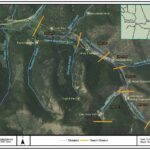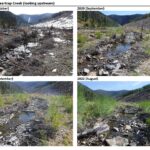History/Background
The Upper Blackfoot Mining Complex (UBMC) is in the historic Heddleston Metal Mining District in Lewis and Clark County, approximately 15 miles east of Lincoln, Montana. The site is within the headwaters of the Upper Blackfoot River and covers an area of approximately 6 square miles. Mining activities began in the UBMC project area in the late 1800s and continued to the 1950s, with exploration activities continuing after the 1950s. The major mine products included lead, zinc, and copper, with some additional production of gold and silver. The majority of UBMC mining activity occurred at the Mike Horse Mine. Mining of the Mike Horse Mine began in 1898 and was expanded into a larger operation in 1919. In 1938, the Mike Horse Mining and Milling Company leased the mine and built a 150 ton-per-day flotation mill.
In 1941, the Mike Horse Dam was built across Beartrap Creek, within the headwaters of the Upper Blackfoot River, to contain the tailings generated from the Mike Horse Mine mill. Heavy rains and high stream flows caused a partial failure of the dam in 1975, eroding contaminated tailings into Beartrap Creek and the Upper Blackfoot River. The breach released an estimated 100,000 tons of tailings and other materials below the dam and into the Upper Blackfoot River.
In 2005, a United States Forest Service (USFS) Dam Safety Report determined that the dam was unsafe and recommended that it be removed from service. In July 2007, USFS released an action memorandum calling for the removal and disposal of the dam, mine tailings, and waste.
In 2008, the State of Montana and USFS successfully reached a settlement with the liable parties, ASARCO LLC (ASACRO) and Atlantic Richfield Company (ARCO), for environmental damages at the Mike Horse site. An agreement with the Montana Department of Environmental Quality (DEQ), the Montana Natural Resource Damage Program (NRDP), and USFS was reached soon after the settlement to coordinate cleanup activities at the site. DEQ is the lead agency coordinating the cleanup. Information about the UBMC, including maps and fact sheets, can be found at DEQ’s website at https://deq.mt.gov/cleanupandrec/Programs/superfundfed
Injured Resources
In 2007, NRDP completed an assessment of injuries and damages within the UBMC using existing data. Groundwater was found to contain metal concentrations exceeding Montana’s human health standards. Surface water in Mike Horse Creek, Beartrap Creek, and the Upper Blackfoot River exhibited concentrations of zinc and cadmium that exceeded acute criteria and were sufficiently high to cause harm to aquatic life. Metal concentrations in sediments from Mike Horse Creek and the Upper Blackfoot River were found to be high enough to be likely to cause injury to benthic invertebrates. Macroinvertebrates were absent from some portions of the Upper Blackfoot River and in other locations only metal-tolerant species were present. Mine tailings in the project area formed sites that were devoid of riparian vegetation.
Restoration Plan
NRDP completed the Draft Conceptual Restoration Plan for the Upper Blackfoot Mining Complex: Restoration of the Stream and Floodplain Ecosystem (Conceptual Restoration Plan) in 2011. This document is a draft conceptual restoration plan for the UBMC project area DEQ and NRDP coordinated the cleanup and restoration activities with the USFS. The Conceptual Restoration Plan was developed in conjunction with remediation planning and proposed general approaches to integrating restoration with remediation activities. The plan proposed ways to integrate remediation and restoration in an efficient and compatible manner in order to maximize benefits to the ecosystem.
Specific elements of the restoration vision included restoring stream channel and floodplain function, creating riparian conditions that exchange nutrients and other materials with the aquatic environment, and providing high-quality habitat for westslope cutthroat trout and other aquatic and terrestrial organisms. Throughout the life of this project, continued coordination among the various state and federal agencies involved with remediation and restoration activities at the UBMC has been critical to achieving restoration goals at the site.
Remediation and Restoration
In 2008, ASARCO constructed the UBMC water treatment plant, which began operation in 2009. Contaminated site water is collected from two mine adits and two seeps and treated at the water treatment plant to remove contaminants including cadmium, copper, iron, lead, manganese, and zinc. Treated water is then discharged to the Upper Blackfoot River. The water treatment plant will be operated in perpetuity and is overseen by DEQ in consultation with USFS.
Remediation and restoration of the site were conducted between 2015 and 2020. This work included removal of the Mike Horse dam as well as tailings and waste in the floodplains of the Mike Horse Creek, Beartrap Creek, Anaconda Creek, and Upper Blackfoot River watersheds. The stream channels and floodplains were reconstructed and restored after removal. The cleanup removed about 1 million cubic yards of tailings and mine waste that had contaminated streams and the adjacent floodplains and injured aquatic life, including fish. The contaminated material was encapsulated in a nearby repository.




